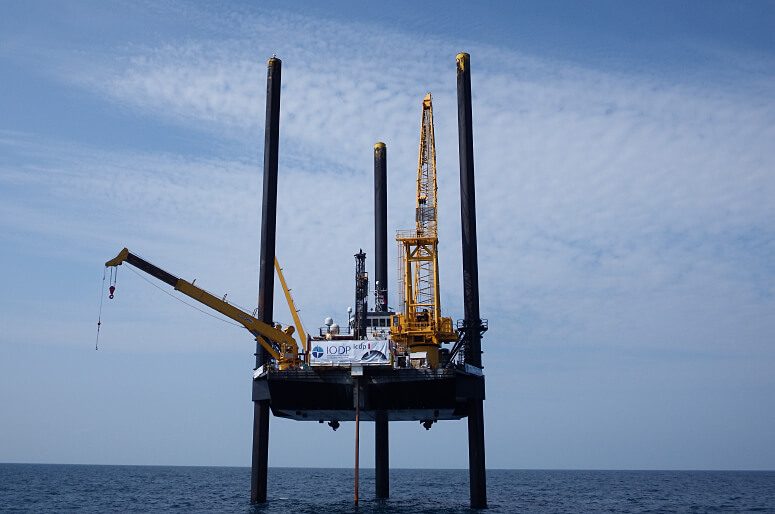October 25, 2018
Underground crater reveals how broken rocks can flow like liquid
 A mile-long sediment core drilled by the International Ocean Discovery Program helped researchers uncover how the Chicxulub crater formed. (International Ocean Discovery Program photo)
Download image
A mile-long sediment core drilled by the International Ocean Discovery Program helped researchers uncover how the Chicxulub crater formed. (International Ocean Discovery Program photo)
Download image
WEST LAFAYETTE, Ind. — Sixty-six million years ago, an asteroid the size of a small city smashed into the earth. This impact, the one that would lead to the end of the dinosaurs, left a scar several miles underground and more than 115 miles wide.
Chicxulub, which lies underneath the Yucatán Peninsula of Mexico, is the best-preserved large impact crater on Earth, although it’s buried underneath a half mile of rocks. It’s also the only crater on the planet with a mountainous ring of smashed rocks inside its outer rim, called a peak ring. How these features form has long been debated, but a new study in Nature shows they’re a product of extremely strong vibrations in the Earth that let rock flow like liquid for a crucial few minutes after the impact.
When an asteroid crashes into the earth, it leaves a bowl-shaped pit, just like you’d expect. But it doesn’t just leave a dent. If the asteroid is big enough, the resulting crater can be more than 20 miles deep, at which point it becomes unstable and collapses.
“For a while, the broken rock behaves as a fluid,” said Jay Melosh, a professor of earth, atmospheric and planetary sciences at Purdue University. “There have been a lot of theories proposed about what mechanism allows this fluidization to happen, and now we know it’s really strong vibrations shaking the rock constantly enough to allow it to flow.”
This mechanism, known as “acoustic fluidization,” is the process that allows the ring of mountains in the crater’s center to rise within minutes of the asteroid’s strike. (This idea was first proposed by Melosh in 1979). Craters are essentially the same on all the terrestrial planets (Earth, Mercury, Venus, Mars and our moon), but they’re hard to study in space for obvious reasons: We can’t look at them with the same detail we can on Earth.
The Chicxulub crater isn’t easily accessible by traditional standards either; it’s been buried throughout the last 66 million years. So, the International Ocean Discovery Program (a group within the International Continental Scientific Drilling Program), did the only thing they could – they dug. The team drilled a core roughly six inches in diameter and a mile into the Earth, collecting rock that was shattered and partly melted by the impact that wiped out the dinosaurs.
In examining fracture zones and patterns in the core, the international research team found an evolution in the vibration sequence that would allow debris to flow.
“These findings help us understand how impact craters collapse and how large masses of rock behave in a fluid-like manner in other circumstances, such as landslides and earthquakes,” Melosh said. “Towns have been wiped out by enormous landslides, where people thought they were safe but then discovered that rock will flow like liquid when some disturbance sets a big enough mass in motion.”
The extinction of the dinosaurs itself was probably not directly affected by the crater’s internal collapse – other, external effects of the impact did them in, Melosh said. Regardless, it’s important to understand the consequences of a large asteroid strike on Earth. Because cratering is the same on all the terrestrial planets, these findings also validate the mechanics of impacts everywhere in the solar system.
This research was supported by grants from the German Science Foundation, National Science Foundation and Natural Environment Research Council. The Chicxulub drilling expedition was funded by the European Consortium for Ocean Research Drilling and the IODP as Expedition 364 with co-funding from the ICDP.
Writer: Kayla Zacharias, 765-494-9318, kzachar@purdue.edu
Source: Jay Melosh, 765-494-3237, jmelosh@purdue.edu
Note to Journalists: For a copy of the paper, please contact Kayla Zacharias, Purdue News Service, kzachar@purdue.edu.
ABSTRACT
Rock fluidization during peak-ring formation of large impact structures
Ulrich Riller1, Michael H. Poelchau, Auriol S. P. Rae, Felix M. Schulte, Gareth S. Collins, H. Jay Melosh, Richard A. F. Grieve, Joanna V. Morgan, Sean P. S. Gulick, Johanna Lofi, Abdoulaye Diaw, Naoma McCall, David A. Kring & the IODP–ICDP Expedition 364 Science Party
Large meteorite impact structures on the terrestrial bodies of the Solar System contain pronounced topographic rings, which emerged from uplifted target (crustal) rocks within minutes of impact. To flow rapidly over large distances, these target rocks must have weakened drastically, but they subsequently regained sufficient strength to build and sustain topographic rings. The mechanisms of rock deformation that accomplish such extreme change in mechanical behaviour during cratering are largely unknown and have been debated for decades. Recent drilling of the approximately 200-km- diameter Chicxulub impact structure in Mexico has produced a record of brittle and viscous deformation within its peak- ring rocks. Here we show how catastrophic rock weakening upon impact is followed by an increase in rock strength that culminated in the formation of the peak ring during cratering. The observations point to quasi-continuous rock flow and hence acoustic fluidization as the dominant physical process controlling initial cratering, followed by increasingly localized faulting.

